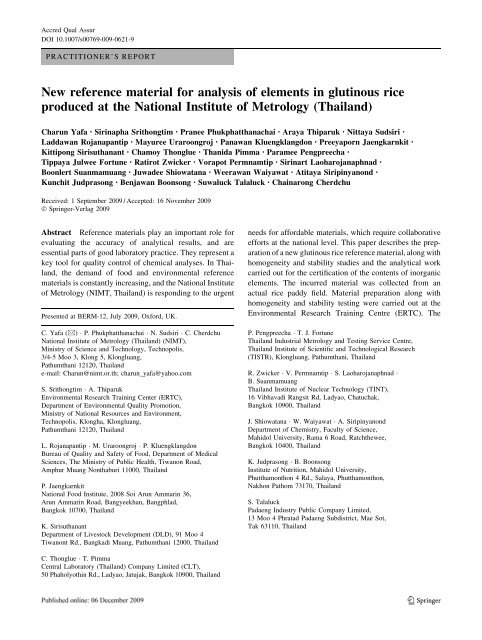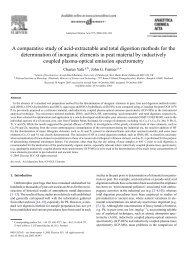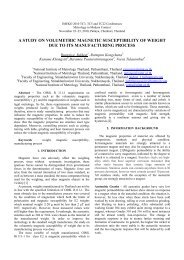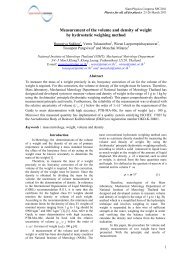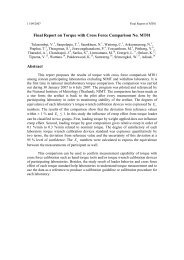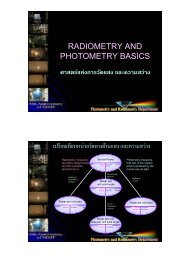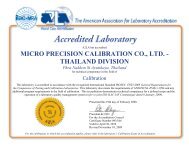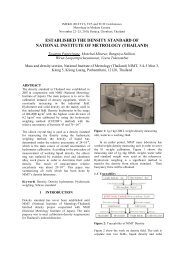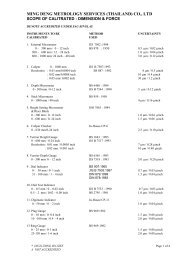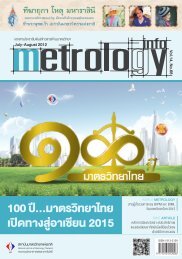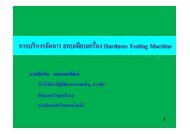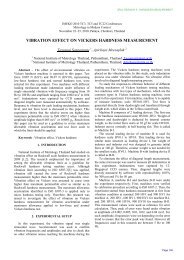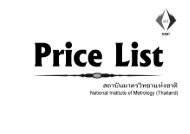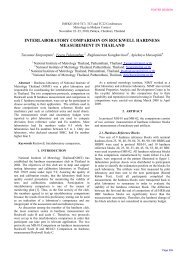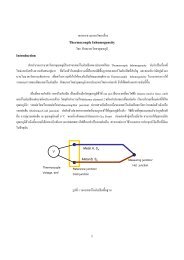New reference material for analysis of elements in glutinous rice ...
New reference material for analysis of elements in glutinous rice ...
New reference material for analysis of elements in glutinous rice ...
Create successful ePaper yourself
Turn your PDF publications into a flip-book with our unique Google optimized e-Paper software.
Accred Qual Assur<br />
DOI 10.1007/s00769-009-0621-9<br />
PRACTITIONER’S REPORT<br />
<strong>New</strong> <strong>reference</strong> <strong>material</strong> <strong>for</strong> <strong>analysis</strong> <strong>of</strong> <strong>elements</strong> <strong>in</strong> glut<strong>in</strong>ous <strong>rice</strong><br />
produced at the National Institute <strong>of</strong> Metrology (Thailand)<br />
Charun Yafa • Sir<strong>in</strong>apha Srithongtim • Pranee Phukphatthanachai • Araya Thiparuk • Nittaya Sudsiri •<br />
Laddawan Rojanapantip • Mayuree Uraroongroj • Panawan Kluengklangdon • Preeyaporn Jaengkarnkit •<br />
Kittipong Sirisuthanant • Chamoy Thonglue • Thanida Pimma • Paramee Pengpreecha •<br />
Tippaya Julwee Fortune • Ratirot Zwicker • Vorapot Permnamtip • Sir<strong>in</strong>art Laoharojanaphnad •<br />
Boonlert Suanmamuang • Juwadee Shiowatana • Weerawan Waiyawat • Atitaya Sirip<strong>in</strong>yanond •<br />
Kunchit Judprasong • Benjawan Boonsong • Suwaluck Talaluck • Cha<strong>in</strong>arong Cherdchu<br />
Received: 1 September 2009 / Accepted: 16 November 2009<br />
Ó Spr<strong>in</strong>ger-Verlag 2009<br />
Abstract Reference <strong>material</strong>s play an important role <strong>for</strong><br />
evaluat<strong>in</strong>g the accuracy <strong>of</strong> analytical results, and are<br />
essential parts <strong>of</strong> good laboratory practice. They represent a<br />
key tool <strong>for</strong> quality control <strong>of</strong> chemical analyses. In Thailand,<br />
the demand <strong>of</strong> food and environmental <strong>reference</strong><br />
<strong>material</strong>s is constantly <strong>in</strong>creas<strong>in</strong>g, and the National Institute<br />
<strong>of</strong> Metrology (NIMT, Thailand) is respond<strong>in</strong>g to the urgent<br />
Presented at BERM-12, July 2009, Ox<strong>for</strong>d, UK.<br />
C. Yafa (&) P. Phukphatthanachai N. Sudsiri C. Cherdchu<br />
National Institute <strong>of</strong> Metrology (Thailand) (NIMT),<br />
M<strong>in</strong>istry <strong>of</strong> Science and Technology, Technopolis,<br />
3/4-5 Moo 3, Klong 5, Klongluang,<br />
Pathumthani 12120, Thailand<br />
e-mail: Charun@nimt.or.th; charun_yafa@yahoo.com<br />
S. Srithongtim A. Thiparuk<br />
Environmental Research Tra<strong>in</strong><strong>in</strong>g Center (ERTC),<br />
Department <strong>of</strong> Environmental Quality Promotion,<br />
M<strong>in</strong>istry <strong>of</strong> National Resources and Environment,<br />
Technopolis, Klongha, Klongluang,<br />
Pathumthani 12120, Thailand<br />
L. Rojanapantip M. Uraroongroj P. Kluengklangdon<br />
Bureau <strong>of</strong> Quality and Safety <strong>of</strong> Food, Department <strong>of</strong> Medical<br />
Sciences, The M<strong>in</strong>istry <strong>of</strong> Public Health, Tiwanon Road,<br />
Amphur Muang Nonthaburi 11000, Thailand<br />
P. Jaengkarnkit<br />
National Food Institute, 2008 Soi Arun Ammar<strong>in</strong> 36,<br />
Arun Ammar<strong>in</strong> Road, Bangyeekhan, Bangphlad,<br />
Bangkok 10700, Thailand<br />
K. Sirisuthanant<br />
Department <strong>of</strong> Livestock Development (DLD), 91 Moo 4<br />
Tiwanont Rd., Bangkadi Muang, Pathumthani 12000, Thailand<br />
C. Thonglue T. Pimma<br />
Central Laboratory (Thailand) Company Limited (CLT),<br />
50 Phaholyoth<strong>in</strong> Rd., Ladyao, Jatujak, Bangkok 10900, Thailand<br />
needs <strong>for</strong> af<strong>for</strong>dable <strong>material</strong>s, which require collaborative<br />
ef<strong>for</strong>ts at the national level. This paper describes the preparation<br />
<strong>of</strong> a new glut<strong>in</strong>ous <strong>rice</strong> <strong>reference</strong> <strong>material</strong>, along with<br />
homogeneity and stability studies and the analytical work<br />
carried out <strong>for</strong> the certification <strong>of</strong> the contents <strong>of</strong> <strong>in</strong>organic<br />
<strong>elements</strong>. The <strong>in</strong>curred <strong>material</strong> was collected from an<br />
actual <strong>rice</strong> paddy field. Material preparation along with<br />
homogeneity and stability test<strong>in</strong>g were carried out at the<br />
Environmental Research Tra<strong>in</strong><strong>in</strong>g Centre (ERTC). The<br />
P. Pengpreecha T. J. Fortune<br />
Thailand Industrial Metrology and Test<strong>in</strong>g Service Centre,<br />
Thailand Institute <strong>of</strong> Scientific and Technological Research<br />
(TISTR), Klongluang, Pathumthani, Thailand<br />
R. Zwicker V. Permnamtip S. Laoharojanaphnad<br />
B. Suanmamuang<br />
Thailand Institute <strong>of</strong> Nuclear Technology (TINT),<br />
16 Vibhavadi Rangsit Rd, Ladyao, Chatuchak,<br />
Bangkok 10900, Thailand<br />
J. Shiowatana W. Waiyawat A. Sirip<strong>in</strong>yanond<br />
Department <strong>of</strong> Chemistry, Faculty <strong>of</strong> Science,<br />
Mahidol University, Rama 6 Road, Ratchthewee,<br />
Bangkok 10400, Thailand<br />
K. Judprasong B. Boonsong<br />
Institute <strong>of</strong> Nutrition, Mahidol University,<br />
Phutthamonthon 4 Rd., Salaya, Phutthamonthon,<br />
Nakhon Pathom 73170, Thailand<br />
S. Talaluck<br />
Padaeng Industry Public Company Limited,<br />
13 Moo 4 Phratad Padaeng Subdistrict, Mae Sot,<br />
Tak 63110, Thailand<br />
123
homogeneity study was designed to have three experimental<br />
conditions; (A) 10 bottles <strong>of</strong> candidate <strong>material</strong>s be<strong>in</strong>g<br />
analyzed each with 2 replicates, (B) 20 bottles with 2 replicates,<br />
(C) 10 bottles with 7 replicates, <strong>in</strong> order to study the<br />
suitable treatments <strong>for</strong> homogeneity test<strong>in</strong>g <strong>in</strong> the <strong>reference</strong><br />
<strong>material</strong> production. It was shown that a m<strong>in</strong>imum number<br />
<strong>of</strong> 10 bottles with duplicate analyses are enough to demonstrate<br />
the homogeneity <strong>of</strong> candidate <strong>reference</strong> <strong>material</strong>.<br />
Certification <strong>of</strong> a candidate <strong>reference</strong> <strong>material</strong> <strong>in</strong> a s<strong>in</strong>gle<br />
laboratory us<strong>in</strong>g <strong>reference</strong> method was confirmed with an<br />
<strong>in</strong>terlaboratory comparison participated by a certa<strong>in</strong> number<br />
<strong>of</strong> well recognized test<strong>in</strong>g laboratories <strong>in</strong> Thailand. Further<br />
elaborative results will be discussed.<br />
Keywords Inorganic <strong>analysis</strong> Elements Rice<br />
Reference <strong>material</strong><br />
Introduction<br />
The world’s anthropogenic sources <strong>of</strong> <strong>in</strong>organic <strong>elements</strong><br />
deposition have been <strong>in</strong>creas<strong>in</strong>g follow<strong>in</strong>g the <strong>in</strong>dustrial revolution<br />
when m<strong>in</strong><strong>in</strong>g, smelt<strong>in</strong>g, electroplat<strong>in</strong>g, and other<br />
<strong>in</strong>dustrial activities are produc<strong>in</strong>g undesirable concentrations<br />
<strong>of</strong> metals, such as Cd, Cr, Cu, Ni, Pb, and Zn, which are not<br />
environmental friendly. Although trace metals are an important<br />
part <strong>of</strong> the soil ecosystem, accumulation <strong>of</strong> these metals is<br />
harmful to people, animals, plants and other organisms com<strong>in</strong>g<br />
<strong>in</strong> contact with the soil and groundwater. It becomes more<br />
dangerous to human when the contam<strong>in</strong>ated soil is cultivated<br />
<strong>for</strong> agricultural purposes. The metal m<strong>in</strong><strong>in</strong>g <strong>in</strong>dustry <strong>in</strong><br />
Thailand’s northern areas released a vast amount <strong>of</strong> cadmium<br />
(Cd), which contam<strong>in</strong>ated the lands and river nearby. The<br />
lands are <strong>rice</strong> farms, which are the traditional sources <strong>of</strong> food<br />
<strong>for</strong> Thais and peoples <strong>in</strong> Asia. Determ<strong>in</strong>ation <strong>of</strong> trace <strong>elements</strong><br />
i.e. Cd, which is one <strong>of</strong> the ma<strong>in</strong> elemental pollutants <strong>in</strong> the<br />
environment, <strong>in</strong> <strong>rice</strong> samples is there<strong>for</strong>e very important from<br />
both a toxicological and nutritional po<strong>in</strong>t <strong>of</strong> views. Cadmium<br />
toxicity is hazardous <strong>for</strong> aquatic animal and plant life. Food is<br />
a pathway <strong>of</strong> the contam<strong>in</strong>ation. In man or animal, the metal is<br />
ma<strong>in</strong>ly accumulated <strong>in</strong> kidney and liver with long biological<br />
half life. Japanese scientists reported a serious health problem<br />
caused by consum<strong>in</strong>g large amount <strong>of</strong> Cd <strong>in</strong> contam<strong>in</strong>ated <strong>rice</strong><br />
and water. Extensive researches later identified a symptom as<br />
‘Itai-itai’ disease. It has to be completely eradicated <strong>in</strong> Japan<br />
and yet their <strong>in</strong>cident is <strong>in</strong>creas<strong>in</strong>g worldwide.<br />
The accurate determ<strong>in</strong>ation <strong>of</strong> Cd <strong>in</strong> <strong>rice</strong> is vital. There<br />
has been a grow<strong>in</strong>g demand <strong>for</strong> <strong>rice</strong> flour national <strong>reference</strong><br />
<strong>material</strong>s certified <strong>for</strong> both toxic and essential metals.<br />
Reference <strong>material</strong>s play an essential role <strong>for</strong> evaluat<strong>in</strong>g<br />
the accuracy <strong>of</strong> analytical results, and are important parts<br />
<strong>of</strong> good laboratory practice [1]. Quality control <strong>of</strong> analytical<br />
results obta<strong>in</strong>ed utiliz<strong>in</strong>g <strong>rice</strong> flour <strong>reference</strong> <strong>material</strong>s<br />
123<br />
is fundamental to the accurate <strong>analysis</strong> <strong>of</strong> <strong>rice</strong>. At present,<br />
several organizations provide <strong>rice</strong> <strong>reference</strong> <strong>material</strong>s certified<br />
<strong>for</strong> trace <strong>elements</strong>. The Japan National Institute <strong>for</strong><br />
Environmental Studies (NIES) developed <strong>rice</strong> flour <strong>reference</strong><br />
<strong>material</strong>s conta<strong>in</strong><strong>in</strong>g three levels <strong>of</strong> Cd. The National<br />
Institute <strong>of</strong> Standards and Technology (NIST) issued<br />
Standard Reference Material 1568 Rice Flour s<strong>in</strong>ce January<br />
1978, though it provides certified values <strong>for</strong> toxic<br />
<strong>elements</strong> at only the normal level. The Korea Research<br />
Institute <strong>of</strong> Standards and Science (KRISS) and the<br />
National Measurement Institute Japan (NMIJ) have <strong>in</strong>itiated<br />
the development <strong>of</strong> <strong>rice</strong> flour <strong>reference</strong> <strong>material</strong>s <strong>for</strong><br />
Cd at both normal and elevated levels [2].<br />
Each National Measurement Institute (NMI) <strong>of</strong> these<br />
countries has developed its own measurement standard <strong>for</strong><br />
the measurement <strong>of</strong> <strong>in</strong>organic <strong>elements</strong> <strong>in</strong> <strong>rice</strong>. In Thailand,<br />
the demand <strong>for</strong> food and environmental <strong>reference</strong> <strong>material</strong>s<br />
is rapidly <strong>in</strong>creas<strong>in</strong>g, NIMT together with ERTC respond<br />
to the urgent needs <strong>for</strong> af<strong>for</strong>dable <strong>material</strong>s which require<br />
collaborative ef<strong>for</strong>ts at the national level. In this research<br />
paper, we describe the preparation <strong>of</strong> a new glut<strong>in</strong>ous <strong>rice</strong><br />
<strong>reference</strong> <strong>material</strong>. Glut<strong>in</strong>ous <strong>rice</strong> is the major food <strong>of</strong><br />
peoples from northern Thailand and some Southeast Asia<br />
countries. No <strong>reference</strong> <strong>material</strong> certified <strong>for</strong> Cd content <strong>in</strong><br />
glut<strong>in</strong>ous <strong>rice</strong> has commercially made available. This <strong>reference</strong><br />
<strong>material</strong> will help improv<strong>in</strong>g the quality <strong>of</strong><br />
analytical results generated from relevant chemical test<strong>in</strong>g<br />
laboratories. It will provide the test<strong>in</strong>g laboratories a <strong>reference</strong><br />
<strong>material</strong> with the same matrix and concentration<br />
range with the field samples they always analyze.<br />
Methods<br />
Reagents<br />
All water used <strong>in</strong> this project is deionized water produced from<br />
the Milli-Q Element system with resistivity <strong>of</strong> 18.2 MX.Nitric<br />
acid used throughout the project is 65% Merck, ‘‘Suprapur’’<br />
(\1 lg L -1 Pb) Merck catalogue number 100441. Stock<br />
standard solutions <strong>of</strong> the <strong>elements</strong> determ<strong>in</strong>ed were prepared<br />
from its corresponded NIST SRM, i.e. NIST SRM3108 <strong>for</strong> Cd,<br />
NIST SRM3114 <strong>for</strong> Cu, NIST SRM3132 <strong>for</strong> Mn, and standard<br />
NIST SRM3168a <strong>for</strong> Zn. Work<strong>in</strong>g standard solutions were<br />
made by serial dilution <strong>of</strong> the stock solutions gravimetrically.<br />
Their correspond<strong>in</strong>g spike isotopic standards, 111 Cd, 65 Cu, and<br />
67 Zn were purchased from Oak Ridge, USA.<br />
Preparation <strong>of</strong> candidate <strong>reference</strong> <strong>material</strong><br />
Accred Qual Assur<br />
A batch (100 kg) <strong>of</strong> <strong>in</strong>curred Cd contam<strong>in</strong>ated, polished<br />
glut<strong>in</strong>ous <strong>rice</strong> was collected from an actual <strong>rice</strong> paddy field.<br />
It was first air dried at room temperature to achieve less
Accred Qual Assur<br />
than 10% moisture content be<strong>for</strong>e be<strong>in</strong>g pulverized with a<br />
rotary mill. About 15 kg <strong>of</strong> f<strong>in</strong>e glut<strong>in</strong>ous <strong>rice</strong> powder was<br />
obta<strong>in</strong>ed. The powder was then sieved through 90 lm sieve<br />
and later mixed <strong>in</strong> a V-shape blender <strong>for</strong> almost a week.<br />
Ten subsamples were taken from the bulk <strong>material</strong> <strong>for</strong> the<br />
prelim<strong>in</strong>ary homogeneity study. After satisfactory homogeneity<br />
level was achieved, the <strong>rice</strong> flour was then<br />
packaged <strong>in</strong> 30 g polypropylene bottles. Four hundred<br />
bottles <strong>of</strong> candidate <strong>rice</strong> <strong>reference</strong> <strong>material</strong> were f<strong>in</strong>ally<br />
obta<strong>in</strong>ed. They were irradiated by c radiation <strong>in</strong> order to<br />
m<strong>in</strong>imize microbial contam<strong>in</strong>ation. The rema<strong>in</strong><strong>in</strong>g <strong>material</strong><br />
was discarded as it was considered to be less homogeneous.<br />
Homogeneity test<strong>in</strong>g<br />
Homogeneity test<strong>in</strong>g <strong>for</strong> mass fractions <strong>of</strong> <strong>elements</strong> <strong>in</strong> the<br />
candidate glut<strong>in</strong>ous <strong>rice</strong> <strong>reference</strong> <strong>material</strong> was ma<strong>in</strong>ly carried<br />
out us<strong>in</strong>g the F test and ANOVA statistical test. Twenty bottles<br />
<strong>of</strong> candidate <strong>rice</strong> <strong>reference</strong> <strong>material</strong> were randomly selected<br />
from the batch. Samples were digested <strong>in</strong> HNO3 us<strong>in</strong>g hotplate<br />
digestion. Approximately 1 g <strong>of</strong> sample was accurately<br />
weighed <strong>in</strong>to a beaker. Two portions <strong>of</strong> 5 ml HNO3 were<br />
added. They were covered with watch glass and then heated on<br />
the hotplate until nearly dry. The rema<strong>in</strong><strong>in</strong>g was then re-dissolved<br />
with deionized water, be<strong>for</strong>e be<strong>in</strong>g filtered through<br />
filter paper and made up to 50 ml. The solution was then<br />
analyzed <strong>for</strong> <strong>in</strong>organic <strong>elements</strong> content by ICP-OES.<br />
Stability study<br />
A literature review shows the good stability <strong>of</strong> <strong>in</strong>organic<br />
<strong>elements</strong> <strong>in</strong> <strong>rice</strong> <strong>material</strong> [2]. It is expected that this glut<strong>in</strong>ous<br />
<strong>rice</strong> <strong>reference</strong> <strong>material</strong> will be stable <strong>for</strong> at least<br />
12 months (especially after c radiation). The long-term<br />
stability <strong>of</strong> the candidate glut<strong>in</strong>ous <strong>rice</strong> <strong>reference</strong> <strong>material</strong><br />
was tested by stor<strong>in</strong>g three bottles <strong>of</strong> the candidate <strong>reference</strong><br />
<strong>material</strong> at ?4 °C <strong>for</strong> a period <strong>of</strong> 6 months. After 1, 3,<br />
and 6 months, mass fraction <strong>of</strong> <strong>elements</strong> were determ<strong>in</strong>ed<br />
<strong>in</strong> two replicates <strong>for</strong> each bottle. The procedures were the<br />
same as those used <strong>in</strong> the homogeneity study. Us<strong>in</strong>g l<strong>in</strong>ear<br />
regression as recommended <strong>in</strong> the ISO Guide 35: 2006 [3],<br />
<strong>in</strong>stability would be detected if the slope <strong>of</strong> the regression<br />
l<strong>in</strong>e deviates from zero. The short-term stability study <strong>of</strong><br />
the candidate glut<strong>in</strong>ous <strong>rice</strong> <strong>reference</strong> <strong>material</strong> was tested<br />
by stor<strong>in</strong>g bottles <strong>of</strong> the candidate <strong>reference</strong> <strong>material</strong> at ?4,<br />
?20, and ?40 °C <strong>for</strong> a period <strong>of</strong> 8 weeks. After 4 and<br />
8 weeks, the mass fractions <strong>of</strong> <strong>elements</strong> were determ<strong>in</strong>ed<br />
(<strong>in</strong> triplicate). The samples stored at ?4 °C were used as<br />
<strong>reference</strong> <strong>for</strong> the samples stored at ?20 and ?40 °C,<br />
respectively. Instability would be detected by compar<strong>in</strong>g<br />
the measured mass fraction <strong>of</strong> <strong>elements</strong> <strong>of</strong> samples stored<br />
at ?20 and ?40 °C with those <strong>of</strong> samples stored at ?4 °C<br />
after 4 and 8 weeks.<br />
Certification <strong>of</strong> concentration with one laboratory<br />
Due to the low level <strong>of</strong> measurement uncerta<strong>in</strong>ty given <strong>for</strong> the<br />
certified <strong>reference</strong> <strong>material</strong>s produced by all reputable and<br />
highly experienced NMIs [4], it was decided to certify this<br />
glut<strong>in</strong>ous <strong>rice</strong> <strong>reference</strong> <strong>material</strong> us<strong>in</strong>g the first approach given<br />
<strong>in</strong> the ISO Guide 34 [5]. A certification with measurement by<br />
one or more (<strong>reference</strong>) method <strong>in</strong> one laboratory has been<br />
employed. A certification <strong>of</strong> Cd, Cu, and Zn mass fractions <strong>in</strong><br />
candidate glut<strong>in</strong>ous <strong>rice</strong> <strong>reference</strong> <strong>material</strong> was <strong>in</strong>itially per<strong>for</strong>med<br />
by Inductively Coupled Plasma-Isotope Dilution<br />
Mass Spectrometry (ICP-IDMS) carried out by NIMT. Where<br />
the IDMS technique is not applicable <strong>for</strong> Mn <strong>analysis</strong>, the<br />
mass fraction <strong>of</strong> Mn is certified based on consensus value<br />
obta<strong>in</strong>ed from <strong>in</strong>terlaboratory comparison.<br />
National <strong>in</strong>terlaboratory comparison<br />
A series <strong>of</strong> national <strong>in</strong>terlaboratory comparison exercise was<br />
conducted <strong>for</strong> confirmation <strong>of</strong> IDMS values. However, <strong>in</strong>terlaboratory<br />
comparison is meant <strong>for</strong> certification <strong>of</strong> Mn content.<br />
Laboratories <strong>in</strong>vited to take part <strong>in</strong> the exercise were reputable,<br />
and highly experienced <strong>in</strong> this field <strong>of</strong> measurement throughout<br />
Thailand, considered to be well-equipped and employ<strong>in</strong>g<br />
quality control and quality assurance procedures. Eleven laboratories<br />
tak<strong>in</strong>g part were requested to verify the quality <strong>of</strong> their<br />
measurements, <strong>in</strong> particular, the validity <strong>of</strong> calibration<br />
(<strong>in</strong>clud<strong>in</strong>g calibration <strong>of</strong> balances, volumetric glass wares and<br />
other tools <strong>of</strong> relevance). They are the Department <strong>of</strong> Medical<br />
Sciences (DMSc), the National Food Institute (NFI), Department<br />
<strong>of</strong> Livestock Development (DLD), Central Laboratory<br />
Thailand (CLT), Thailand Institute <strong>of</strong> Scientific and Technological<br />
Research (TISTR), Thailand Institute <strong>of</strong> Nuclear<br />
Technology (TINT), Department <strong>of</strong> Chemistry, Mahidol University<br />
(MU), Institute <strong>of</strong> Nutrition, Mahidol University<br />
(INMU), Padaeng Industry Public Company Limited, Environmental<br />
Research and Tra<strong>in</strong><strong>in</strong>g Centre (ERTC), and the<br />
National Institute <strong>of</strong> Metrology (Thailand) (NIMT). Participants<br />
were free to choose analytical methods <strong>of</strong> which they had<br />
previous experience and could there<strong>for</strong>e be expected to give<br />
valid results when applied by an experienced analyst. They<br />
were also asked to make a m<strong>in</strong>imum <strong>of</strong> five <strong>in</strong>dependent replicate<br />
determ<strong>in</strong>ations <strong>of</strong> each element <strong>in</strong> the candidate <strong>reference</strong><br />
<strong>material</strong>, each laboratory be<strong>in</strong>g supplied with one bottle <strong>of</strong><br />
prepared candidate <strong>rice</strong> <strong>material</strong>.<br />
Results and discussion<br />
Homogeneity test<strong>in</strong>g<br />
In order to study the suitable treatments <strong>for</strong> homogeneity<br />
test<strong>in</strong>g <strong>in</strong> the <strong>reference</strong> <strong>material</strong> production, this<br />
123
experiment was designed to have three experimental conditions.<br />
In the first set <strong>of</strong> experiment (A), 10 bottles <strong>of</strong><br />
candidate <strong>material</strong>s were analyzed, each with 2 replicates.<br />
In the second set <strong>of</strong> experiment (B), 20 bottles <strong>of</strong> candidate<br />
<strong>material</strong>s were analyzed, each also with 2 replicates. The<br />
third experiment (C) was carried out by analyz<strong>in</strong>g 10<br />
bottles <strong>of</strong> candidate <strong>material</strong>s, each with 7 replicates. The<br />
three set <strong>of</strong> experiments were tested <strong>for</strong> homogeneity us<strong>in</strong>g<br />
ANOVA. To evaluate the level <strong>of</strong> work needed to carry out<br />
<strong>for</strong> homogeneity test<strong>in</strong>g, the uncerta<strong>in</strong>ty due to homogeneity<br />
study aris<strong>in</strong>g from each condition was compared.<br />
Table 1 displays analytical results <strong>of</strong> Cd, expressed <strong>in</strong><br />
mg kg -1 on a dry-mass basis, <strong>for</strong> treatment A (10 bottles, 2<br />
replicates), B (20 bottles, 2 replicates), and C (10 bottles, 7<br />
replicates). Their correspond<strong>in</strong>g parameters calculated<br />
from ANOVA, i.e. mean squares with<strong>in</strong> bottle (MSwith<strong>in</strong>),<br />
mean squares between bottles (MS between), F calculation<br />
(Fcal), F critical (Fcrit), P value are summarized <strong>in</strong> Table 2.<br />
Cochran’s test is employed to test <strong>for</strong> outlier due to variation<br />
<strong>of</strong> analytical method <strong>in</strong> each bottle. This test<br />
<strong>in</strong>dicated the good per<strong>for</strong>mance <strong>of</strong> analyst who per<strong>for</strong>med<br />
the analyses. From Tables 1 and 2, where it can be seen<br />
that Fcal does not exceed Fcrit with P value is greater than 0.05,<br />
there is strong evidence, at the 95% confidence level, that from<br />
these three sets <strong>of</strong> experiments the candidate glut<strong>in</strong>ous <strong>rice</strong><br />
<strong>reference</strong> <strong>material</strong> is homogeneous <strong>for</strong> Cd content. Uncerta<strong>in</strong>ty<br />
due to <strong>in</strong>homogeneity (ubb) was calculated us<strong>in</strong>g the<br />
expression given <strong>in</strong> the ISO Guide 35: 2006.<br />
rffiffiffiffiffiffiffiffiffiffiffiffiffiffiffiffiffiffiffiffiffiffiffiffiffiffiffiffiffiffiffiffiffiffiffiffiffiffiffi<br />
MSbetween MSwith<strong>in</strong><br />
ubb ¼<br />
n0<br />
In case where MSbetween is close to MSwith<strong>in</strong>, the<br />
follow<strong>in</strong>g calculation was employed:<br />
rffiffiffiffiffiffiffiffiffiffiffiffiffiffiffi<br />
sffiffiffiffiffiffiffiffiffiffiffiffiffi<br />
4 2<br />
ubb ¼<br />
MSwith<strong>in</strong><br />
n<br />
mMSwith<strong>in</strong><br />
The same treatment was applied to other <strong>elements</strong> <strong>of</strong><br />
<strong>in</strong>terest, <strong>in</strong> each case demonstrat<strong>in</strong>g the homogeneity <strong>of</strong> the<br />
candidate <strong>material</strong>. Table 3 summarizes uncerta<strong>in</strong>ty due to<br />
<strong>in</strong>homogeneity aris<strong>in</strong>g from those three sets <strong>of</strong> experiments<br />
<strong>for</strong> all four <strong>elements</strong>. On the basis <strong>of</strong> these results, the<br />
<strong>material</strong> was considered to be homogeneous at the level <strong>of</strong><br />
1.0 g. From Table 3, it can be seen that all three sets <strong>of</strong><br />
experiments yielded the relative standard uncerta<strong>in</strong>ty due<br />
Table 1 Data <strong>for</strong> mass fraction <strong>of</strong> Cd (mg kg -1 ) (dry-mass basis, i.e. corrected <strong>for</strong> moisture content) <strong>for</strong> the three treatments <strong>of</strong> homogeneity<br />
study <strong>of</strong> the candidate glut<strong>in</strong>ous <strong>rice</strong> <strong>reference</strong> <strong>material</strong><br />
No. Mass fraction <strong>of</strong> Cd (mg kg -1 )<br />
Treatment A Treatment B Treatment C<br />
10 bottles, 2 replicates 20 bottles, 2 replicates 10 bottles, 7 replicates<br />
Rep1 Rep2 Rep1 Rep2 Rep1 Rep2 Rep3 Rep4 Rep5 Rep6 Rep7<br />
1 0.65 0.65 0.65 0.65 0.60 0.61 0.58 0.62 0.59 0.56 0.58<br />
2 0.67 0.63 0.65 0.67 0.61 0.58 0.59 0.58 0.58 0.60 0.60<br />
3 0.67 0.68 0.69 0.66 0.58 0.60 0.58 0.58 0.58 0.59 0.59<br />
4 0.67 0.66 0.68 0.68 0.58 0.59 0.61 0.62 0.59 0.61 0.60<br />
5 0.68 0.65 0.67 0.65 0.59 0.59 0.60 0.60 0.61 0.62 0.58<br />
6 0.68 0.66 0.67 0.68 0.61 0.59 0.59 0.59 0.59 0.59 0.61<br />
7 0.61 0.64 0.68 0.68 0.59 0.57 0.61 0.61 0.63 0.61 0.59<br />
8 0.63 0.62 0.67 0.64 0.62 0.60 0.59 0.57 0.60 0.54 0.59<br />
9 0.64 0.69 0.68 0.65 0.58 0.61 0.60 0.58 0.60 0.58 0.59<br />
10 0.66 0.67 0.69 0.64 0.58 0.59 0.61 0.58 0.60 0.60 0.59<br />
11 0.66 0.66<br />
12 0.67 0.66<br />
13 0.66 0.67<br />
14 0.69 0.66<br />
15 0.66 0.65<br />
16 0.68 0.68<br />
17 0.67 0.64<br />
18 0.66 0.68<br />
19 0.69 0.66<br />
20 0.65 0.66<br />
Rep replicate<br />
123<br />
Accred Qual Assur
Accred Qual Assur<br />
Table 2 Analysis <strong>of</strong> variance (ANOVA) from three treatments <strong>of</strong> the homogeneity test<strong>in</strong>g <strong>of</strong> mass fraction <strong>of</strong> Cd (mg kg -1 ) <strong>in</strong> the candidate<br />
glut<strong>in</strong>ous <strong>rice</strong> <strong>reference</strong> <strong>material</strong><br />
to <strong>in</strong>homogeneity (ubb) <strong>of</strong> approximately 1%. It po<strong>in</strong>ted out<br />
that the number <strong>of</strong> bottles taken <strong>for</strong> <strong>analysis</strong> and number <strong>of</strong><br />
replicate <strong>analysis</strong> does not affect results <strong>of</strong> homogeneity<br />
study. Ten sub-samples with two replicates <strong>analysis</strong> are<br />
sufficient to demonstrate the homogeneity <strong>of</strong> the candidate<br />
<strong>material</strong>. This f<strong>in</strong>d<strong>in</strong>g corresponds with many literatures [4]<br />
previously written on the homogeneity study <strong>of</strong> <strong>reference</strong><br />
<strong>material</strong>. In this certification exercise, it was decided to<br />
employ <strong>in</strong><strong>for</strong>mation from 10 bottles <strong>of</strong> candidate <strong>material</strong><br />
with 2 replicate analyses.<br />
Stability study<br />
Treatment A Treatment B Treatment C<br />
10 bottles, 2 replicates 20 bottles, 2 replicates 10 bottles, 7 replicates<br />
MSwith<strong>in</strong> 0.000334 0.000245 0.000255<br />
MSbetween 0.000589 0.000180 0.000166<br />
Fcal 1.764 0.737 0.652<br />
Fcrit 3.020 2.137 2.040<br />
P value 0.194 0.745 0.748<br />
MS with<strong>in</strong> mean squares with<strong>in</strong> bottle, MS between mean squares between bottles, F cal F calculation, F crit F critical<br />
Table 3 Relative standard uncerta<strong>in</strong>ty due to between-bottle <strong>in</strong>homogeneity (u bb) aris<strong>in</strong>g from those three set <strong>of</strong> experiments <strong>for</strong> all four<br />
<strong>elements</strong><br />
Experimental conditions Relative standard uncerta<strong>in</strong>ty due to between-bottle <strong>in</strong>homogeneity (u bb)<br />
This candidate glut<strong>in</strong>ous <strong>reference</strong> <strong>material</strong> is subjected to<br />
long term stability study over a period <strong>of</strong> 6 months. There<br />
is no apparent physical/chemical damage observed dur<strong>in</strong>g<br />
this period <strong>of</strong> time. The experimental data are given <strong>in</strong><br />
Table 4. As described <strong>in</strong> the ISO Guide 35:2006, there is<br />
no physical/chemical model that would realistically<br />
describe a degradation mechanism <strong>for</strong> this k<strong>in</strong>d <strong>of</strong> <strong>material</strong>.<br />
The straight l<strong>in</strong>e model is employed as empirical model<br />
Cd (%) Cu (%) Mn (%) Zn (%)<br />
A (10 bottles, 2 replicates) 1.3 1.4 0.5 0.6<br />
B (20 bottles, 2 replicates) 0.9 1.1 0.4 0.4<br />
C (10 bottles, 7 replicates) 0.7 1.1 0.4 0.4<br />
Table 4 Long-term stability<br />
study <strong>of</strong> candidate glut<strong>in</strong>ous <strong>rice</strong><br />
<strong>reference</strong> <strong>material</strong> over a period<br />
<strong>of</strong> 6 months<br />
Time (months) Mass fraction <strong>of</strong> <strong>elements</strong> (mg kg -1 )<br />
Cd Cu Mn Zn<br />
0 0.62 1.4 7.4 19.1<br />
1 0.62 1.4 7.4 19.2<br />
3 0.61 1.4 7.4 19.1<br />
6 0.62 1.4 7.4 19.2<br />
Relative standard uncerta<strong>in</strong>ty due to <strong>in</strong>stability (ustab) 3% 2% 2% 1%<br />
(y = b1x ? b0). For this k<strong>in</strong>d <strong>of</strong> <strong>material</strong>, it is expected that<br />
the <strong>in</strong>tercept is (with<strong>in</strong> uncerta<strong>in</strong>ty) equal to the values on<br />
the day <strong>of</strong> zero. It is also expected that the slope does not<br />
significantly differ from zero. Figure 1 shows <strong>in</strong><strong>for</strong>mation<br />
obta<strong>in</strong>ed from stability test<strong>in</strong>g. Us<strong>in</strong>g Cd as example, the<br />
regression l<strong>in</strong>e is obta<strong>in</strong>ed as: y =-0.000048x ? 0.618.<br />
The slope (b1) is equal to -0.000048, with its associated<br />
uncerta<strong>in</strong>ty [s(b1)] <strong>of</strong> 0.00186. The <strong>in</strong>tercept (b0) is 0.618.<br />
Accord<strong>in</strong>g to the ISO Guide 35:2006, the slope <strong>in</strong>significantly<br />
differs from zero, and hence no <strong>in</strong>stability is<br />
observed if |b 1| \ t 0.95,n-2 s(b 1). In this case, the student<br />
factor <strong>for</strong> n - 2 degree <strong>of</strong> freedom and P = 0.95 (95%<br />
confidence level) is equal to 4.30. It is proven that the slope<br />
is <strong>in</strong>significant, hence no <strong>in</strong>stability was observed. By<br />
apply<strong>in</strong>g the same treatment with Cu, Mn, and Zn, no<br />
<strong>in</strong>stability was detected over a period <strong>of</strong> study. The<br />
uncerta<strong>in</strong>ty due to <strong>in</strong>stability (u stab) is calculated us<strong>in</strong>g the<br />
follow<strong>in</strong>g expression: ustab = s(b1) t. Table 4 shows<br />
uncerta<strong>in</strong>ty due to <strong>in</strong>stability over a shelf life <strong>of</strong> 12 months.<br />
As <strong>for</strong> the short-term stability, the ratios (R T) <strong>of</strong> the<br />
mean values (xT) <strong>of</strong> triplicate measurements made <strong>for</strong><br />
123
Mass fraction <strong>of</strong> Cd (mg/kg)<br />
Mass fraction <strong>of</strong> Mn (mg/kg)<br />
0.65<br />
0.63<br />
0.61<br />
0.59<br />
0.57<br />
0.55<br />
7.7<br />
7.6<br />
7.5<br />
7.4<br />
7.3<br />
7.2<br />
7.1<br />
7.0<br />
samples stored at ?20 and ?40 °C and the mean value<br />
(xþ4 C) from the three determ<strong>in</strong>ations at ?4 °C were calculated<br />
as:<br />
RT ¼ x T =xþ4 C:<br />
The comb<strong>in</strong>ed uncerta<strong>in</strong>ty at each temperature (uc,T)<br />
was obta<strong>in</strong>ed from the coefficient <strong>of</strong> variation (CV) <strong>of</strong> three<br />
measurements:<br />
uc;T ¼ RT<br />
0 2 4 6 8<br />
Time (months)<br />
0 1 2 3 4 5 6 7<br />
Time (months)<br />
Fig. 1 Stability study <strong>for</strong> Cd, Cu, Mn, and Zn <strong>in</strong> candidate <strong>rice</strong> <strong>reference</strong> <strong>material</strong><br />
qffiffiffiffiffiffiffiffiffiffiffiffiffiffiffiffiffiffiffiffiffiffiffiffiffiffiffiffiffiffiffiffiffiffiffiffiffi<br />
:<br />
ðs=xÞ 2<br />
T<br />
ðs=xÞ 2<br />
þ4 C<br />
The RT ratio should be 1 <strong>in</strong> the case <strong>of</strong> ideal stability.<br />
But as slight <strong>in</strong>stability might be expected at the high<br />
temperature, the value 1 should lie between RT - uc,T and<br />
RT ? uc,T. From this experiment, more than 98% <strong>of</strong> the<br />
measurements made <strong>for</strong> samples stored at ?20 and ?40 °C<br />
conditions, the values fell with<strong>in</strong> RT ± uc,T. It was<br />
concluded that there was no <strong>in</strong>stability dur<strong>in</strong>g transport.<br />
As a result <strong>of</strong> the stability test<strong>in</strong>g, the candidate <strong>material</strong><br />
was considered to be suitable <strong>for</strong> certification, provided<br />
that the <strong>material</strong> is stored at typical room temperature or<br />
under refrigeration.<br />
Certification <strong>of</strong> concentration <strong>in</strong> s<strong>in</strong>gle laboratory<br />
Analytical data obta<strong>in</strong>ed at NIMT were quantified by the<br />
Isotope Dilution (ID), which is an especially useful method<br />
when a sample has to undergo some chemical pre-treatment<br />
123<br />
Mass fraction <strong>of</strong> Cu (mg/kg)<br />
Mass fraction <strong>of</strong> Zn (mg/kg)<br />
1.50<br />
1.45<br />
1.40<br />
1.35<br />
1.30<br />
19.5<br />
19.3<br />
19.1<br />
18.9<br />
18.7<br />
0 2 4 6 8<br />
Time (months)<br />
18.5<br />
0 2 4 6 8<br />
Time (months)<br />
Accred Qual Assur<br />
be<strong>for</strong>e <strong>analysis</strong>, because any loss <strong>of</strong> analyte dur<strong>in</strong>g the pretreatment<br />
does not affect the f<strong>in</strong>al results. The ID method is<br />
based on the spik<strong>in</strong>g <strong>of</strong> a known amount <strong>of</strong> a <strong>material</strong> <strong>of</strong><br />
same element with different isotopic composition. After<br />
equilibration, the isotope ratio <strong>of</strong> two selected isotopes <strong>in</strong> the<br />
blend is measured us<strong>in</strong>g a mass spectrometer. The IDMS<br />
technique [6] carried out at NIMT is called ‘‘Double IDMS’’.<br />
The double IDMS <strong>analysis</strong> can be carried out <strong>in</strong> such a way<br />
as to m<strong>in</strong>imize the need <strong>for</strong> correction factors due to mass<br />
discrim<strong>in</strong>ation and l<strong>in</strong>earity effects by us<strong>in</strong>g a technique<br />
known as exact match<strong>in</strong>g. In this technique, the sample and<br />
calibration standard are both spiked with the same amount <strong>of</strong><br />
the same spike solution; and the amount <strong>of</strong> analyte <strong>in</strong> the<br />
calibration standard is matched to be the same as <strong>in</strong> the<br />
sample. This will remove the effect <strong>of</strong> any systematic error<br />
associated with measurement <strong>of</strong> these ratios when they are<br />
measured consecutively over a short period <strong>of</strong> time.<br />
Us<strong>in</strong>g the IDMS exact match<strong>in</strong>g technique, the glut<strong>in</strong>ous<br />
<strong>rice</strong> flour samples were decomposed with an AntonParr<br />
Multiwave 3000 microwave digestion system. About<br />
500 mg <strong>of</strong> the <strong>rice</strong> flour sample placed <strong>in</strong> a Teflon vessel,<br />
5 ml <strong>of</strong> HNO3 and 1 ml <strong>of</strong> H2O2 were added <strong>in</strong>to the vessel<br />
together with appropriate amounts <strong>of</strong> their correspond<strong>in</strong>g<br />
spike isotopes. The samples were digested <strong>in</strong>side a<br />
microwave oven with a digestion program <strong>of</strong> 1000 W <strong>for</strong><br />
35 m<strong>in</strong>. After cool<strong>in</strong>g, they were diluted to about 50 ml.<br />
They were then analyzed <strong>for</strong> Cd, Cu, and Zn mass fractions
Accred Qual Assur<br />
Table 5 Digestion methods<br />
and <strong>in</strong>strumental analytical<br />
techniques used by participants<br />
<strong>in</strong> the <strong>in</strong>terlaboratory<br />
comparison exercise <strong>for</strong><br />
elemental concentrations <strong>in</strong><br />
candidate <strong>rice</strong> <strong>reference</strong><br />
<strong>material</strong><br />
by ICP-QMS us<strong>in</strong>g IDMS equation. The ICP-MS <strong>in</strong>strument<br />
employed <strong>in</strong> this work was a Perk<strong>in</strong>Elmer SCIEX<br />
ELAN DRC II ICP-QMS. Details <strong>of</strong> the <strong>in</strong>strument operat<strong>in</strong>g<br />
conditions are as follows: RF power 1125 W, plasma gas<br />
flow rate 15 L m<strong>in</strong> -1 , nebulizer gas flow rate 0.91 L m<strong>in</strong> -1 ,<br />
and auxiliary gas flow rate 1.2 L m<strong>in</strong> -1 .<br />
Where the IDMS technique is not applicable <strong>for</strong> Mn<br />
<strong>analysis</strong>, the certified value is calculated from the consensus<br />
value obta<strong>in</strong>ed from <strong>in</strong>terlaboratory comparison.<br />
This value was subsequently confirmed by <strong>analysis</strong> <strong>of</strong> Mn<br />
mass fraction <strong>in</strong> s<strong>in</strong>gle laboratory. The candidate <strong>material</strong><br />
was carefully analyzed <strong>for</strong> mass fraction by ICP-OES. The<br />
LAB ID Sample preparation Analytical techniques<br />
LAB1 AOAC 2005: 199.10 GF-AAS<br />
LAB2 1 g/HNO3, HClO4/Hotplate digestion ICP-OES<br />
LAB3 1.5 g/HNO3, HClO4/Block digester ICP-OES<br />
LAB4 AOAC 2005: 199.10 ICP-OES/ICP-MS<br />
LAB5 HNO3, HClO4/Hotplate AAS<br />
LAB6 0.2 g INAA<br />
LAB7 0.5 g/HNO3,H2O2/Microwave digestion ICP-OES<br />
LAB8 Microwave digestion ICP-MS/ICP-OES<br />
LAB9 10 g/HNO3, HClO4, HCl/Hotplate digestion ICP-OES<br />
LAB10 1 g/HNO3/Hotplate digestion ICP-OES<br />
LAB11 0.25 g/HNO3,H2O2/Microwave digestion ICP-MS<br />
LAB12 0.25 g/HNO3,H2O2/Microwave digestion ICP-MS<br />
ICP-OES <strong>in</strong>strument employed <strong>in</strong> this work was an<br />
ICP-OES Perk<strong>in</strong>Elmer Optima 2000 DV. Details <strong>of</strong> the<br />
<strong>in</strong>strument operat<strong>in</strong>g conditions are as follows: RF power<br />
1500 W, plasma gas flow rate 15 L m<strong>in</strong> -1 , nebulizer gas<br />
flow rate 0.7 L m<strong>in</strong> -1 , auxiliary gas flow rate 0.2 L m<strong>in</strong> -1 ,<br />
with the wavelength <strong>of</strong> 257.610 nm.<br />
Uncerta<strong>in</strong>ty evaluation <strong>of</strong> Cd, Cu, Mn, and Zn <strong>analysis</strong><br />
Measurement uncerta<strong>in</strong>ty <strong>for</strong> Cd, Cu, and Zn <strong>analysis</strong><br />
carried out by IDMS are calculated accord<strong>in</strong>g to the Guide<br />
on the Expression <strong>of</strong> Uncerta<strong>in</strong>ty <strong>in</strong> Measurement (GUM<br />
Fig. 2 The sets <strong>of</strong> results from <strong>in</strong>terlaboratory comparison <strong>for</strong> Cd, Cu, Mn, and Zn accepted on technical and statistical grounds compared with<br />
values obta<strong>in</strong>ed from measurement <strong>in</strong> s<strong>in</strong>gle laboratory (except Mn)<br />
123
1995), and EURACHEM (2000) expression. Uncerta<strong>in</strong>ty<br />
from characterization <strong>for</strong> Mn was estimated accord<strong>in</strong>g to<br />
guide l<strong>in</strong>e given <strong>in</strong> the ISO Guide 35: 2006.<br />
National <strong>in</strong>terlaboratory comparison<br />
As <strong>for</strong> the <strong>in</strong>terlaboratory comparison, on receipt <strong>of</strong> data<br />
from participants, an identification number (Laboratory ID)<br />
was assigned to each laboratory. N<strong>in</strong>e laboratories reported<br />
data <strong>for</strong> Cd and Zn mass fractions, eight laboratories <strong>for</strong> Cu<br />
and Mn mass fraction, us<strong>in</strong>g a range <strong>of</strong> digestion conditions<br />
(HNO 3-based acid comb<strong>in</strong>ation) and a variety <strong>of</strong> analytical<br />
techniques (AAS, GFAAS, ICP-OES, ICP-MS), <strong>in</strong>clud<strong>in</strong>g,<br />
<strong>in</strong> the case <strong>of</strong> one laboratory, INAA <strong>analysis</strong> <strong>of</strong> the solid<br />
phase. Table 5 lists the digestion methods and <strong>in</strong>strumental<br />
analytical techniques used by the participants.<br />
The sets <strong>of</strong> results submitted by participants were<br />
assumed to be normally distributed and analyzed statistically<br />
us<strong>in</strong>g Grubbs and Cochran’s tests to detect outly<strong>in</strong>g<br />
values. The Grubbs test was used to detect outly<strong>in</strong>g values<br />
<strong>in</strong> the population <strong>of</strong> <strong>in</strong>dividual results and <strong>in</strong> the population<br />
<strong>of</strong> laboratory means, while Cochran’s test was used to<br />
identify outly<strong>in</strong>g values <strong>in</strong> the laboratory variances. The<br />
sets <strong>of</strong> results from <strong>in</strong>terlaboratory comparison accepted on<br />
technical and statistical grounds are also presented <strong>in</strong><br />
Fig. 2. Table 6 shows the mass fractions <strong>of</strong> Cd, Cu, and Zn<br />
carried out by IDMS <strong>analysis</strong> at NIMT, along with Mn<br />
result obta<strong>in</strong>ed from ICP-OES <strong>analysis</strong> at ERTC compared<br />
with results obta<strong>in</strong>ed from the <strong>in</strong>terlaboratory comparison.<br />
It showed no significant differ between results obta<strong>in</strong>ed<br />
from the two approaches.<br />
Certification and calculation <strong>of</strong> uncerta<strong>in</strong>ty <strong>of</strong> <strong>reference</strong><br />
<strong>material</strong><br />
Aga<strong>in</strong>, us<strong>in</strong>g Cd as the example, the uncerta<strong>in</strong>ty <strong>of</strong> the<br />
value assigned to the Cd concentration (0.69 mg kg -1 )<strong>of</strong><br />
the glut<strong>in</strong>ous <strong>rice</strong> certified <strong>reference</strong> <strong>material</strong> was calculated<br />
accord<strong>in</strong>g to a modification <strong>of</strong> the GUM [7–11] and<br />
the recommends given <strong>in</strong> the ISO Guide 35: 2006, us<strong>in</strong>g<br />
the equation:<br />
ffiffiffiffiffiffiffiffiffiffiffiffiffiffiffiffiffiffiffiffiffiffiffiffiffiffiffiffiffiffiffiffiffiffiffiffi<br />
UCRM ¼ k u2 char þ u2 bb þ u2 q<br />
stab<br />
where U CRM denotes expanded uncerta<strong>in</strong>ty <strong>of</strong> the total Cd<br />
concentration <strong>of</strong> the glut<strong>in</strong>ous <strong>rice</strong> certified <strong>reference</strong><br />
<strong>material</strong>, k coverage factor, uchar uncerta<strong>in</strong>ty <strong>of</strong> the certified<br />
metal concentration <strong>in</strong> the candidate glut<strong>in</strong>ous <strong>rice</strong> <strong>reference</strong><br />
<strong>material</strong>, ubb uncerta<strong>in</strong>ty <strong>of</strong> the between-bottle<br />
<strong>in</strong>homogeneity, ustab uncerta<strong>in</strong>ty <strong>of</strong> the <strong>in</strong>stability. Table 7<br />
summarizes <strong>in</strong><strong>for</strong>mation used <strong>for</strong> certification <strong>of</strong> mass<br />
fraction <strong>of</strong> <strong>elements</strong> and their associated certified values.<br />
Future work<br />
In the future this candidate glut<strong>in</strong>ous <strong>rice</strong> will be characterized<br />
<strong>for</strong> some more other <strong>elements</strong> i.e. As, Cr, Pb, and Hg. Stability<br />
<strong>of</strong> the <strong>reference</strong> <strong>material</strong> will be cont<strong>in</strong>uously monitored.<br />
Table 6 Analytical results <strong>of</strong> Cd, Cu, Mn, and Zn from <strong>in</strong>terlaboratory comparison compare to values obta<strong>in</strong>ed by IDMS <strong>analysis</strong> per<strong>for</strong>med at<br />
NIMT, along with values <strong>of</strong> Mn <strong>analysis</strong> taken from ICP-OES <strong>analysis</strong> us<strong>in</strong>g external calibration<br />
Elements Mass fraction <strong>of</strong> <strong>elements</strong> from<br />
<strong>in</strong>terlaboratory comparison<br />
(mg kg -1 )(x ± 1s)<br />
Cd 0.63 ± 0.09 0.69 ± 0.02<br />
Cu 1.7 ± 0.6 1.5 ± 0.05<br />
Mn 7.8 ± 0.5 7.5 ± 0.2*<br />
Zn 22.0 ± 4.3 21.2 ± 0.4<br />
*Value <strong>for</strong> Mn <strong>analysis</strong> was taken from ICP-OES <strong>analysis</strong> us<strong>in</strong>g external calibration<br />
Mass fraction <strong>of</strong> <strong>elements</strong><br />
from IDMS (mg kg -1 )(x ± u c)<br />
Table 7 Certified values with uncerta<strong>in</strong>ties (coverage factor <strong>of</strong> 2) <strong>for</strong> the mass fraction <strong>of</strong> Cd, Cu, Mn, and Zn <strong>in</strong> the glut<strong>in</strong>ous <strong>rice</strong> <strong>reference</strong><br />
<strong>material</strong><br />
Elements Mass fraction<br />
(mg kg -1 )<br />
Standard uncerta<strong>in</strong>ty (mg kg -1 ) Comb<strong>in</strong>e uncerta<strong>in</strong>ty<br />
(mg kg -1 uchar ubb ustab )<br />
Accred Qual Assur<br />
U (k = 2) Certified values<br />
(mg kg -1 )<br />
Cd 0.69 0.02 0.01 0.02 0.03 0.06 0.69 ± 0.06<br />
Cu 1.5 0.05 0.02 0.03 0.06 0.1 1.5 ± 0.1<br />
Mn 7.8 0.5 0.04 0.2 0.5 1.0 7.8 ± 1.0<br />
Zn 21.2 0.4 0.1 0.2 0.5 1.0 21.2 ± 1.0<br />
123
Accred Qual Assur<br />
Applicability and availability<br />
Although this glut<strong>in</strong>ous <strong>rice</strong> <strong>reference</strong> <strong>material</strong> has been<br />
developed specifically <strong>for</strong> use <strong>in</strong> the <strong>analysis</strong> <strong>of</strong> glut<strong>in</strong>ous<br />
<strong>rice</strong>, it may also be <strong>of</strong> some value <strong>in</strong> the <strong>analysis</strong> <strong>of</strong> some<br />
other type <strong>of</strong> <strong>rice</strong> <strong>material</strong>. Enquiries concern<strong>in</strong>g the<br />
availability <strong>of</strong> this <strong>material</strong> should be made to NIMT, from<br />
whom <strong>in</strong>structions <strong>for</strong> use can also be obta<strong>in</strong>ed.<br />
Conclusion<br />
This study confirmed that the number <strong>of</strong> samples or number<br />
<strong>of</strong> replicates measurements is not so critical <strong>for</strong> the<br />
homogeneity test<strong>in</strong>g <strong>in</strong> the process <strong>for</strong> production <strong>of</strong> <strong>reference</strong><br />
<strong>material</strong>. A m<strong>in</strong>imum number <strong>of</strong> 10 samples with 2<br />
replicates measurements per<strong>for</strong>med on each sample were<br />
sufficient to demonstrate homogeneity <strong>of</strong> the candidate<br />
<strong>reference</strong> <strong>material</strong>. Another conclusion that can be drawn<br />
from this study is the sample preparation is not a critical<br />
issue <strong>for</strong> determ<strong>in</strong>ation <strong>of</strong> <strong>in</strong>organic <strong>elements</strong> <strong>in</strong> <strong>rice</strong> sample.<br />
It was proven that an open digestion on the hotplate<br />
can easily give the analytical results relatively close (with<strong>in</strong><br />
its uncerta<strong>in</strong>ty) to the results obta<strong>in</strong>ed by microwave<br />
digestion. Microwave digestion <strong>of</strong> <strong>rice</strong> flour samples with<br />
HNO3 alone or <strong>in</strong> comb<strong>in</strong>ation with other organic acids<br />
was adequate <strong>for</strong> the accurate determ<strong>in</strong>ation <strong>of</strong> Cd, Cu, and<br />
Zn. The IDMS method employed <strong>in</strong> the present work<br />
enabled accurate and precise determ<strong>in</strong>ation <strong>of</strong> the analytes<br />
<strong>in</strong> spite <strong>of</strong> non-quantitative recovery.<br />
Acknowledgments We gratefully acknowledge assistance from<br />
Dr. Pantip Klomjek <strong>of</strong> Naresuan University and Mr. Chaiwat<br />
Phadermrod <strong>of</strong> the Padaeng Industry Public Company Limited <strong>in</strong> the<br />
collection <strong>of</strong> the start<strong>in</strong>g <strong>material</strong>. We are <strong>in</strong> debt to ERTC member<br />
<strong>of</strong> staffs, Sununtha Boonprakong, Watjar<strong>in</strong> Panyasa, Nuttaporn<br />
Sukhakasikorn, Phornjit Mungwongsa, Prakong Kotarapong, Wichai<br />
Rattanasriboonya, and Kamonchanok Tiyawan, <strong>for</strong> their hard work <strong>in</strong><br />
the preparation <strong>of</strong> candidate <strong>material</strong>. Special thanks go to the<br />
Thailand Institute <strong>of</strong> Nuclear Technology (TINT) <strong>for</strong> facilitat<strong>in</strong>g the<br />
radiation <strong>of</strong> the sample. F<strong>in</strong>ally, we would like to express our deep<br />
appreciation to the National Institute <strong>of</strong> Metrology, Thailand (NIMT)<br />
<strong>for</strong> sponsor<strong>in</strong>g this project.<br />
References<br />
1. Barwick V, Burke S, Lawn R, Roper P, Walker R (2001)<br />
Application <strong>of</strong> <strong>reference</strong> <strong>material</strong>s <strong>in</strong> analytical chemistry. The<br />
Royal Society <strong>of</strong> Chemistry, Cambridge, UK<br />
2. Park CJ, Suh JK (1997) J Anal At Spectrom 12:573–577<br />
3. International Organisation <strong>for</strong> Standardisation, Certification <strong>of</strong><br />
Reference Materials–General and Statistical Pr<strong>in</strong>ciples (2006)<br />
ISO Guide 35-2006(E) (2006). ISO, Geneva<br />
4. Walker R, Lawn R, Roper P, Holcombe G, Stuart B (2001) Low-<br />
Cost QC laboratory <strong>reference</strong> <strong>material</strong>s <strong>in</strong>vestigation <strong>of</strong> costeffective<br />
production procedures. LGC/VAM/2001/009, LGC,<br />
London, UK<br />
5. International Organisation <strong>for</strong> Standardisation (2009) General<br />
requirements <strong>for</strong> the competence <strong>of</strong> <strong>reference</strong> <strong>material</strong> producers,<br />
Draft ISO Guide 34-2009(E). ISO, Geneva<br />
6. Myors RB, Nolan AL, Shane A, Saxby DL, Hearn R, Mackay LG<br />
(2005) J Anal At Spectrom 20:1051–1057<br />
7. Pauwels J, Lambert A, Schimmel H (1998) Accred Qual Assur<br />
3:180<br />
8. Pauwels J, Van der Veen AMH, Lambert A, Schimmel H (2000)<br />
Accred Qual Assur 5:95<br />
9. L<strong>in</strong>s<strong>in</strong>ger TPJ, Pauwels J, Schimmel H, Lambert A, Van der<br />
Veen AMH, Schumann G, Siekmann L (2000) Fresenius J Anal<br />
Chem 368:589<br />
10. Van der Veen AMH, Pauwels J (2000) Accred Qual Assur 5:464<br />
11. Van der Veen AMH, L<strong>in</strong>s<strong>in</strong>ger TP, Pauwels J (2001) Accred<br />
Qual Assur 6:26<br />
123


